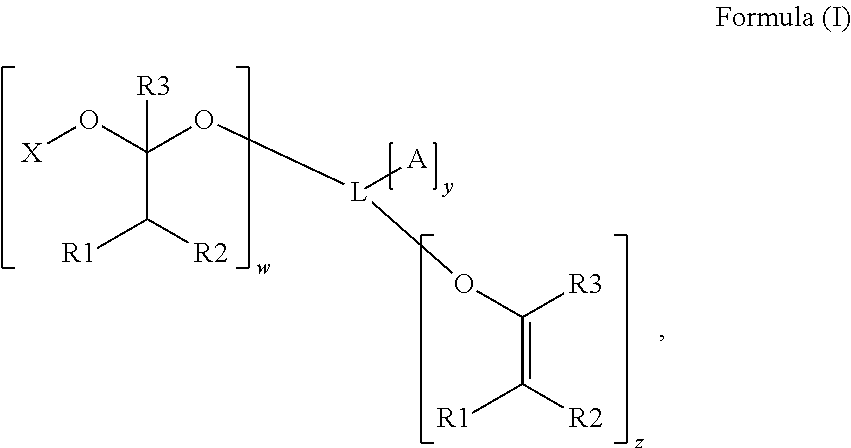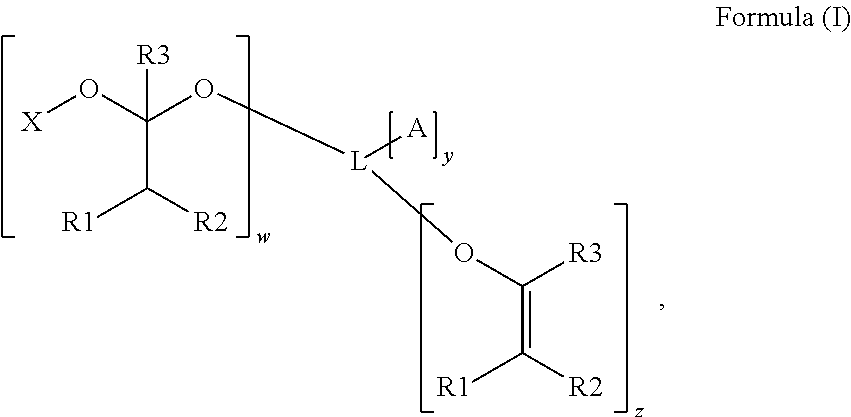Polymerizable photoinitiators and radiation curable compositions
a technology of photoinitiators and compositions, applied in the field of polymerizable photoinitiators, can solve the problems of low molecular weight, difficult to achieve the effect of reducing the amount of extractable residues, and avoiding the need for a large amount of extraction, etc., and achieves the effect of simple and cost-effective synthetic procedures
- Summary
- Abstract
- Description
- Claims
- Application Information
AI Technical Summary
Benefits of technology
Problems solved by technology
Method used
Image
Examples
example 1
[0340]This example illustrates the broad scope of photoinitiators containing a hydroxyl group that can be converted into polymerizable initiators in accordance with a preferred embodiment of the present invention by a particularly convenient synthetic procedure.
Pretreatment of the Ion Exchanger:
[0341]25 g of LEWATIT™ M600 MB was treated with 75 mL of 1 N sodium hydroxide solution and stirred for 2 hours. The ion exchanger was isolated by filtration, washed several times with water and dried until constant weight.
Synthesis:
[0342]The amount of the photoinitiator containing a hydroxyl group (=starting initiator) as specified in Table 3, was dissolved in the amount 2-(2-vinyloxyethoxy)ethyl acrylate (Ether-1), specified in Table 3. 1 mol % BHT, relative to 2-(2-vinyloxyethoxy)ethyl acrylate, was added, followed by the addition of 5 mol % of trifluoroacetic acid, relative to the hydroxyl containing photoinitiating moiety. The reaction was allowed to continue for the specified reaction ti...
example 2
[0349]This example illustrates the polymerizable initiators in accordance with a preferred embodiment of the present invention can be prepared with different vinylether monomers according to Formula (II).
Synthesis:
[0350]The amount of the hydroxyl containing photoinitiating photoinitiator (=starting initiator) as specified in Table 4, was dissolved in the amount of a vinyl ether containing monomer as specified in Table 4. 1 mol % BHT, relative to vinyl ether containing monomer, was added, followed by the addition of 5 mol % of trifluoroacetic acid, relative to the hydroxyl containing photoinitiating moiety. The reaction was allowed to continue for the specified reaction time at 50° C. 25 g of the pretreated ion exchanger was added and the reaction mixture was stirred for 1 hour at room temperature. The ion exchanger was removed by filtration. The degree of conversion was determined using 1H-NMR. The presence of residual catalyst was determined, using 19F-NMR. The resulting polymeriza...
example 3
[0353]This example illustrates the need for a catalyst to convert the photoinitiators containing a hydroxyl group into polymerizable photoinitiators according to a preferred embodiment of the present invention.
Synthesis:
[0354]A set of four starting initiators were allowed to react as specified in Table 5. The degree of conversion was determined using TLC chromatography.
[0355]
TABLE 5Starting InitiatorEther-1ReactionReactionDegree ofTypeAmountAmounttemperaturetimeconversionSTIN-27.5 g31.4 g50° C.72 hNo conversion(1)STIN-17.5 g31.4 g50° C.72 hNo conversion(2)STIN-157.5 g31.4 g50° C.72 hNo conversion(3)STIN-207.5 g31.4 g50° C.72 hNo conversion(4)[0356](1) reference: INI-8: Rf=0.42, Partisil KC18F, supplied by Whatman, eluent MeOH / NaCl 0.5 M 80 / 20.[0357](2) reference: INI-4: Rf=0.32, Partisil KC18F, supplied by Whatman, eluent MeOH / NaCl 0.5 M 80 / 20.[0358](3) reference: INI-1: Rf=0.38, Partisil KC18F, supplied by Whatman, eluent MeOH / NaCl 0.5 M 80 / 20[0359](4) reference: INI-6: Rf=0.33, Pa...
PUM
| Property | Measurement | Unit |
|---|---|---|
| solubility | aaaaa | aaaaa |
| molar ratio | aaaaa | aaaaa |
| molar ratio | aaaaa | aaaaa |
Abstract
Description
Claims
Application Information
 Login to View More
Login to View More - R&D
- Intellectual Property
- Life Sciences
- Materials
- Tech Scout
- Unparalleled Data Quality
- Higher Quality Content
- 60% Fewer Hallucinations
Browse by: Latest US Patents, China's latest patents, Technical Efficacy Thesaurus, Application Domain, Technology Topic, Popular Technical Reports.
© 2025 PatSnap. All rights reserved.Legal|Privacy policy|Modern Slavery Act Transparency Statement|Sitemap|About US| Contact US: help@patsnap.com



